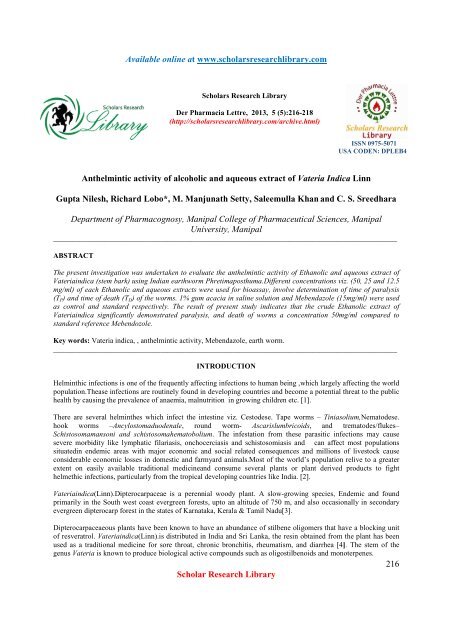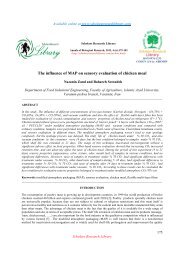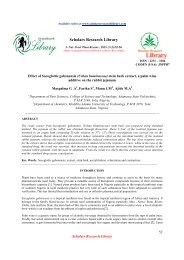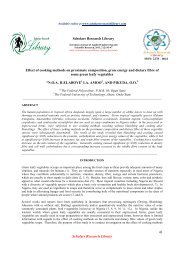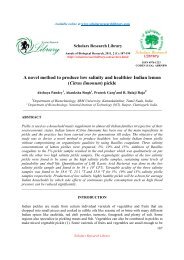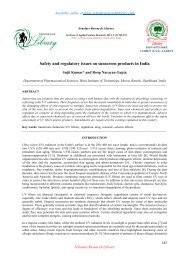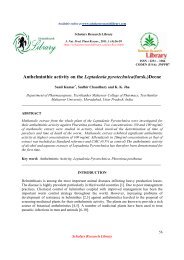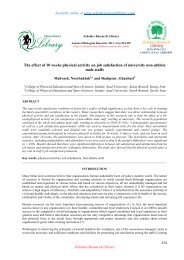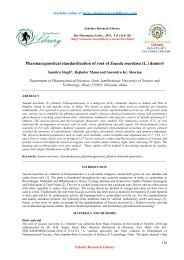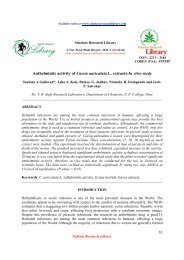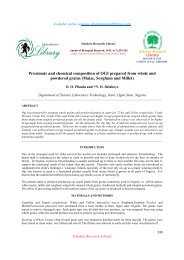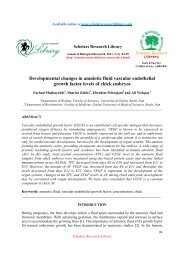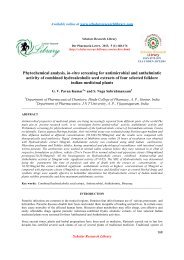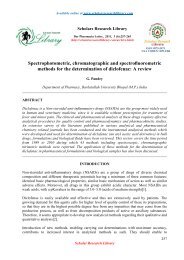Available online at www.scholarsresearchlibrary.com 216 Scholar ...
Available online at www.scholarsresearchlibrary.com 216 Scholar ...
Available online at www.scholarsresearchlibrary.com 216 Scholar ...
Create successful ePaper yourself
Turn your PDF publications into a flip-book with our unique Google optimized e-Paper software.
<strong>Available</strong> <strong>online</strong> <strong>at</strong> <strong>www</strong>.<strong>scholarsresearchlibrary</strong>.<strong>com</strong><br />
<strong>Scholar</strong>s Research Library<br />
Der Pharmacia Lettre, 2013, 5 (5):<strong>216</strong>-218<br />
(http://<strong>scholarsresearchlibrary</strong>.<strong>com</strong>/archive.html)<br />
ISSN 0975-5071<br />
USA CODEN: DPLEB4<br />
Anthelmintic activity of alcoholic and aqueous extract of V<strong>at</strong>eria Indica Linn<br />
Gupta Nilesh, Richard Lobo*, M. Manjun<strong>at</strong>h Setty, Saleemulla Khan and C. S. Sreedhara<br />
Department of Pharmacognosy, Manipal College of Pharmaceutical Sciences, Manipal<br />
University, Manipal<br />
_____________________________________________________________________________________________<br />
ABSTRACT<br />
The present investig<strong>at</strong>ion was undertaken to evalu<strong>at</strong>e the anthelmintic activity of Ethanolic and aqueous extract of<br />
V<strong>at</strong>eriaindica (stem bark) using Indian earthworm Phretimaposthuma.Different concentr<strong>at</strong>ions viz. (50, 25 and 12.5<br />
mg/ml) of each Ethanolic and aqueous extracts were used for bioassay, involve determin<strong>at</strong>ion of time of paralysis<br />
(T P ) and time of de<strong>at</strong>h (T D ) of the worms. 1% gum acacia in saline solution and Mebendazole (15mg/ml) were used<br />
as control and standard respectively. The result of present study indic<strong>at</strong>es th<strong>at</strong> the crude Ethanolic extract of<br />
V<strong>at</strong>eriaindica significantly demonstr<strong>at</strong>ed paralysis, and de<strong>at</strong>h of worms a concentr<strong>at</strong>ion 50mg/ml <strong>com</strong>pared to<br />
standard reference Mebendozole.<br />
Key words: V<strong>at</strong>eria indica, , anthelmintic activity, Mebendazole, earth worm.<br />
_____________________________________________________________________________________________<br />
INTRODUCTION<br />
Helminthic infections is one of the frequently affecting infections to human being ,which largely affecting the world<br />
popul<strong>at</strong>ion.Thease infections are routinely found in developing countries and be<strong>com</strong>e a potential thre<strong>at</strong> to the public<br />
health by causing the prevalence of anaemia, malnutrition in growing children etc. [1].<br />
There are several helminthes which infect the intestine viz. Cestodese. Tape worms – Tiniasolium,Nem<strong>at</strong>odese.<br />
hook worms –Ancylostomaduodenale, round worm- Ascarislumbricoids, and trem<strong>at</strong>odes/flukes–<br />
Schistosomamansoni and schistosomahem<strong>at</strong>obolium. The infest<strong>at</strong>ion from these parasitic infections may cause<br />
severe morbidity like lymph<strong>at</strong>ic filariasis, onchocerciasis and schistosomiasis and can affect most popul<strong>at</strong>ions<br />
situ<strong>at</strong>edin endemic areas with major economic and social rel<strong>at</strong>ed consequences and millions of livestock cause<br />
considerable economic losses in domestic and farmyard animals.Most of the world’s popul<strong>at</strong>ion relive to a gre<strong>at</strong>er<br />
extent on easily available traditional medicineand consume several plants or plant derived products to fight<br />
helmethic infections, particularly from the tropical developing countries like India. [2].<br />
V<strong>at</strong>eriaindica(Linn).Dipterocarpaceae is a perennial woody plant. A slow-growing species, Endemic and found<br />
primarily in the South west coast evergreen forests, upto an altitude of 750 m, and also occasionally in secondary<br />
evergreen dipterocarp forest in the st<strong>at</strong>es of Karn<strong>at</strong>aka, Kerala & Tamil Nadu[3].<br />
Dipterocarpaceaeous plants have been known to have an abundance of stilbene oligomers th<strong>at</strong> have a blocking unit<br />
of resver<strong>at</strong>rol. V<strong>at</strong>eriaindica(Linn).is distributed in India and Sri Lanka, the resin obtained from the plant has been<br />
used as a traditional medicine for sore thro<strong>at</strong>, chronic bronchitis, rheum<strong>at</strong>ism, and diarrhea [4]. The stem of the<br />
genus V<strong>at</strong>eria is known to produce biological active <strong>com</strong>pounds such as oligostilbenoids and monoterpenes.<br />
<strong>216</strong><br />
<strong>Scholar</strong> Research Library
Richard Lobo et al Der Pharmacia Lettre, 2013, 5 (5):<strong>216</strong>-218<br />
______________________________________________________________________________<br />
MATERIALS AND METHODS<br />
Plant m<strong>at</strong>erial<br />
V<strong>at</strong>eria indica (Linn) Stem bark was collected from Manipal and around of Manipal, Karn<strong>at</strong>aka, India during the<br />
month of August-September 2011. The plant was authentic<strong>at</strong>ed by Dr. Gopala Krishna Bh<strong>at</strong>, botanist, taxonomist<br />
,PoornaPrjna College , UdupiKarn<strong>at</strong>aka. A voucher specimen (PP 584)has been deposited in the department of<br />
Pharmacognosy, Manipal College of Pharmaceutical sciences, Manipal India<br />
Prepar<strong>at</strong>ion of Ethanolic and aqueous extract<br />
The stem barks of V<strong>at</strong>eria indica were shade dried, coarsely powered and about 100g of crude powder drug was<br />
extracted with ethanol by hot extraction process (Soxhlet). After <strong>com</strong>pletion of the extraction the solvent was<br />
recovered by distill<strong>at</strong>ion in vacuo. The aqueous extraction of V<strong>at</strong>eria indica was prepared by macer<strong>at</strong>ion process<br />
with 100g of the stem bark power using chloroform: w<strong>at</strong>er (1:99) for seven days, after <strong>com</strong>pletion of the extraction,<br />
filtered, concentr<strong>at</strong>ed in vacuo .<br />
The test samples were prepared <strong>at</strong> the concentr<strong>at</strong>ion 50mg/ml, 25mg/ml and 12.5mg/ml in normal saline containing<br />
1% gum acacia. Suspension normal saline containing 1% acacia and 15mg/ml Mebendazole used as control and<br />
standardrespectively.<br />
Worm collection and authentic<strong>at</strong>ion<br />
Phretimaposthuma(Indian earthworm, phylum: Annelida) were obtained from Vermiculture lab Manipal. It was<br />
identified <strong>at</strong> the department of Pharmacognosy, Manipal University, Manipal, Karn<strong>at</strong>aka.<br />
Antihelmintic activity:<br />
The anthelmintic assay was carried as per the method of M<strong>at</strong>hew et al.,and Dash et al.[5,6,7]with little modific<strong>at</strong>ions<br />
,using adult Indian earthworm Pheritimaposthuma due toresemblance an<strong>at</strong>omically and physiologically with the<br />
intestinal round worm parasite which are responsible to causes infest<strong>at</strong>ion in human being [8,9].Because of easy<br />
availability, earthwormshave been widely used for the initial evalu<strong>at</strong>ion of anthelmintic activityin vitro[10,11].Five<br />
groups of approxim<strong>at</strong>ely equal size Indian earthworms consisting of four in each group were released in 50 ml of<br />
desired solutions containing different concentr<strong>at</strong>ions of crude extract (50, 25, and 12.5mg/ml) and standard<br />
Mebendazole (15mg/ml) in normal saline containing 1% gum acacia.Suspension of only normal saline containing<br />
1% gum acacia was served as control. The time of paralysis (T P ) was noted when no movement of could be<br />
observed except when the worms were shaken vigorously. Time for de<strong>at</strong>h (T D ) was recorded after ascertaining th<strong>at</strong><br />
worms neither moved when shaken vigorously nor when dipped in warm w<strong>at</strong>er (50 0 C).<br />
St<strong>at</strong>istical analysis<br />
The d<strong>at</strong>a are expressed as Mean + SD and analyzed by using one way analysis of variance (ANOVA), followed by<br />
post hoc sheffe’s test using SPSS <strong>com</strong>puter software version 10. The values were considered significant when<br />
p
Richard Lobo et al Der Pharmacia Lettre, 2013, 5 (5):<strong>216</strong>-218<br />
______________________________________________________________________________<br />
Table 1: Anthelmintic activity of Ethanolic and aqueous extract of V<strong>at</strong>eriaindica Linn (stem bark)<br />
Test substance Concentr<strong>at</strong>ion in mg/ml Time taken for paralysis in min. Time taken for de<strong>at</strong>h in min.<br />
Vehicle - - -<br />
Mebendazole 15 mg/ml 20.06 + 0.050 29.01 +0.58<br />
50mg/ml 44.39 + 0.82 49.51 + 1.05<br />
Ethanolic extract 25 mg/ml 48.95 + 0.523 60.02 +1.35<br />
12.5 mg/ml 69.30 + 0.911 82.22 +1.48<br />
50 mg/ml 46.56 + 0.367 51.25+0.933<br />
Aqueous extract 25 mg/ml 69.09+0.43 79.89 +0.307<br />
12.5 mg/ml 71.92 +0.357 118.64 +2.037<br />
All the value are expressed as mean+ SD (n = 4)<br />
Acknowledgement<br />
The authors sincerely thank, Manipal University, Manipal College of pharmaceutical sciences, Manipal, India for<br />
providing all facilities to carry out this study.<br />
REFRRENCES<br />
[1] DAPBunday.Trans Royal Soc Trop Med Hygine , 1994, 8, 259-261.<br />
[2] S<strong>at</strong>yav<strong>at</strong>i GV.Use of plantdrugs in Indian traditional system of medicine and their relevance to primary health<br />
care, In :Economic and medicinal plant research by FranworthNR and Wagner H (Eds), Academic Press Ltd ,<br />
London,1990, PP.190-210.<br />
[3]K.R Venktesh; C.K. Sushrutha..Intern<strong>at</strong>ional journal of research in Ayurveda and Pharmacy,2010, 1(1), 1-7.<br />
[4]K.R,Kirtikar;Basu B. D, An I. C. S., “Indian Medicinal Plants,” Vol.1, Dehra Dun, India, pp.281—293.<br />
[5] M<strong>at</strong>hewAS;KNP<strong>at</strong>el;,BK Shah. Indian J. of N<strong>at</strong>. Prod,1995,4(1),11.<br />
[6] DashGK; B Mishra; A Panda; CP Parto; S Ganap<strong>at</strong>i.Indian J. N<strong>at</strong>. Prod, 2003, 19(3), 24.<br />
[7] Dash GK; Suresh; SK Sahu; DM Kar; S Ganap<strong>at</strong>i; SBPanda.J N<strong>at</strong>. Remed,2002, 2(2), 182.<br />
[8]R.D Vidhyarthi. A text book of zoology, 14th edition, S. Chand and Co., New Delhi, 1977, 329-370.<br />
[9]K.D Ch<strong>at</strong>terjee; Paracitology, Proctology, and Helminthology, Cuha Ray SreeSarasw<strong>at</strong>ypressLtd, Calcutta, 1968,<br />
pp.168-169.<br />
[10]. M.L Jain;SRJain..Planta. Med, 1972, 22, 66-70.<br />
[11]. YMShivaker,VLKumar.Pharma.Bilo, 2003, 41(4), 263-265.<br />
[12]RJ Martin.Br. J. Pharmacology, 1985, 84(2), 445-46.<br />
<strong>Scholar</strong> Research Library<br />
218


